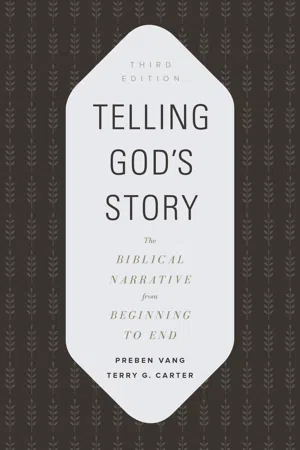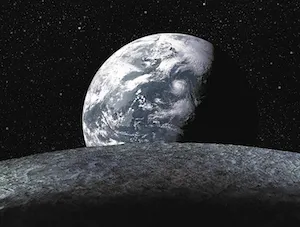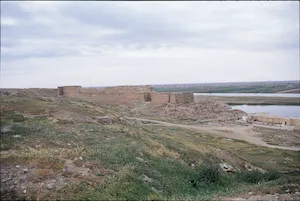
eBook - ePub
Telling God's Story
The Biblical Narrative from Beginning to End
- 544 pages
- English
- ePUB (mobile friendly)
- Available on iOS & Android
eBook - ePub
About this book
Telling God's Story looks closely at the Bible from its beginning in Genesis to its conclusion in Revelation. By approaching Scripture as one purposefully flowing narrative, emphasizing the inter-connectedness of the text, veteran college professors Preben Vang and Terry G. Carter reinforce the Bible's greatest teachings and help readers in their own ability to share God's story effectively with others. Updated to include more interaction with biblical theology and a new section on the intertestamental period, this third edition of Telling God's Story is ideal for Christians seeking to grow in their understanding of God's Word.
Frequently asked questions
Yes, you can cancel anytime from the Subscription tab in your account settings on the Perlego website. Your subscription will stay active until the end of your current billing period. Learn how to cancel your subscription.
No, books cannot be downloaded as external files, such as PDFs, for use outside of Perlego. However, you can download books within the Perlego app for offline reading on mobile or tablet. Learn more here.
Perlego offers two plans: Essential and Complete
- Essential is ideal for learners and professionals who enjoy exploring a wide range of subjects. Access the Essential Library with 800,000+ trusted titles and best-sellers across business, personal growth, and the humanities. Includes unlimited reading time and Standard Read Aloud voice.
- Complete: Perfect for advanced learners and researchers needing full, unrestricted access. Unlock 1.4M+ books across hundreds of subjects, including academic and specialized titles. The Complete Plan also includes advanced features like Premium Read Aloud and Research Assistant.
We are an online textbook subscription service, where you can get access to an entire online library for less than the price of a single book per month. With over 1 million books across 1000+ topics, we’ve got you covered! Learn more here.
Look out for the read-aloud symbol on your next book to see if you can listen to it. The read-aloud tool reads text aloud for you, highlighting the text as it is being read. You can pause it, speed it up and slow it down. Learn more here.
Yes! You can use the Perlego app on both iOS or Android devices to read anytime, anywhere — even offline. Perfect for commutes or when you’re on the go.
Please note we cannot support devices running on iOS 13 and Android 7 or earlier. Learn more about using the app.
Please note we cannot support devices running on iOS 13 and Android 7 or earlier. Learn more about using the app.
Yes, you can access Telling God's Story by Preben Vang,Terry G. Carter in PDF and/or ePUB format, as well as other popular books in Théologie et religion & Études bibliques. We have over one million books available in our catalogue for you to explore.
Information
Episode 1

Creation
Act 1

The Story Begins
Genesis 1–2
Every story has a beginning, and God’s is no exception. The beginning found in Genesis 1–2 provides the biblical answer to the questions of where we are and who we are. In other words, how did everything that exists get here? Many ancient cultures tried to provide answers to that question. For instance, the Babylonians wrote an account of beginnings called Enuma Elish. The Babylonian story focused on polytheism, with creation being the result of the gods behaving badly.1 In contrast, the biblical story centers around one true God who wills to create. Every event from that time on finds its source in God. What do we find in the biblical story of beginnings?

GOD CREATES EX NIHILO
The biblical story tells us how all these things around us (light, dark, earth, sky, water, land, fish, dogs, cats, us) came to be, but it does not say the same about the main character—God. The Bible just assumes that God exists. “In the beginning God” (Gen 1:1). He simply existed as the only being already in existence. That leads us to an awesome conclusion. If God alone existed when he created, then he created everything from nothing.2 Theologians call this creation ex nihilo. God simply called or spoke everything into existence. So where are we? We are in a world created entirely by God. That is the biblical explanation for the beginning of life and the world. God’s story centers on God, who by his nature and power speaks all that is into being.
What does that mean to us? First, all things, including people, owe their being and continued life to God. It means that the creating God is powerful beyond all imagination. He required nothing but himself to create. He created from his own resources and will. Creation completely belongs to God. He cares about and participates in the created world. God spoke into existence all things, relates to the creation, sustains it, and rules over all.
THE CREATION

Eastern Wall of Doura Europa and the Euphrates River
According to the Bible, the process of God’s creation followed a planned pattern. In what Genesis calls six days,3 God unfolded the plan. The story says that on the first day God created light where before there was only darkness, and he separated the light from the darkness. “God saw that the light was good” (Gen 1:4). God continued on the second day by speaking into existence the firmament, or sky. The sky separated the earth from all other entities in the universe. Again, God declared this creation good. On the third day, God made the bodies of water, dry ground, and vegetation. “And God saw that it was good” (v. 12). On the fourth day God made the sun, moon, seasons, and days. “And God saw that it was good” (v. 18). God created fish for the bodies of water and birds to fill the sky, each according to its own kind, on the fifth day. “And God saw that it was good” (v. 21). And then on the sixth day, he made animals each according to its own kind, and finally the crown of creation—humans. “Then God said, ‘Let us make man in our image, according to our likeness. They will rule. . . .’ So God created man in his own image; he created him in the image of God; he created them male and female” (vv. 26–27). The man and woman (humanity) were blessed and given the task of filling the earth and ruling over the other creatures. God gave them the garden as their place for living and the plants within it to sustain them. “God saw all that he had made, and it was very good indeed” (v. 31). God rested on the seventh day after his self-proclaimed good work. This description appears in the first section of God’s creation story found in Gen 1:1–2:3.
The Crown of the Creation
God provides a more detailed explanation of human origins in Gen 2:4–25. God fashioned the first man, called Adam, from the dust and “breathed the breath of life into his nostrils, and the man became a living being” (v. 7). Man was placed in a garden in the east with trees for food that were pleasing to the eyes. In the middle of the garden stood two unique trees, the tree of life and the tree of the knowledge of good and evil. God instructed Adam that he could eat of any tree except the tree of the knowledge of good and evil. To eat from it was to die. Although Adam communicated with God and tended God’s garden, he was the only human. Nothing among the created order corresponded with man, as was the case with the animals. God said, “It is not good for the man to be alone. I will make a helper corresponding to him” (v. 18). “Corresponding to,” or opposite him, indicates that the woman would be complementary, equal, and “even able to respond to him and even challenge him.”4 How did God create this woman? God caused Adam to fall into a deep sleep; and from one of his ribs, he made the first woman, Eve. As equal partners in humanity, they were commanded to be fruitful and multiply. With this action God established the first social unit of the creation, the family. Together Adam and Eve served God and communicated with him daily in the garden.
This story of God’s creation of Adam and Eve means that all people on earth are connected to these two original humans. God related to them and created them, male and female, for relationship. Humans form families and are family in a larger sense. With the creation of Eve came the first marriage relationship and, from that, the first family. This formed the basic structure for society. “And the man said: ‘This one, at last, is bone of my bone and flesh of my flesh; this one will be called “woman,” for she was taken from man.’ This is why a man leaves his father and mother and bonds with his wife, and they become one flesh” (Gen 2:23–24).
Woman became man’s helper or partner. She shared in the responsibility of filling the earth and overseeing the creation. God’s wisdom recognized that two are better than one for they can help and relate to each other (Eccl 4:7–9). The two multiplied and eventually filled the earth. They grew from family to nation to nations of people.
The Image of God
Who are these humans? What made them so unique from the other animals created? Some argue that people are just more advanced animals, but the story says more: “Let us make man in our image, according to our likeness” (Gen 1:26). God created humans in his image, in his likeness. What could that mean? Surely it does not refer merely to physical qualities, or could it? John Calvin argued that “in man’s body ‘some sparks’ of God’s image glow.”5 But later the biblical story clearly states that God is Spirit. Some biblical scholars make a distinction between “image” and “likeness.” Likeness indicates that man is not identical to God but reflects God. Interpretations vary on the image of God. What can we know about the biblical use of image and likeness in describing humans in the created order? First, humankind serves as viceroy over creation—God’s place of dominion. Second, people possess a filial relationship to God as part of his family and therefore have family likeness. Third, humans have a dignity and value connected to their unique relationship to God.6
But what else does the image of God mean? On the more practical level, some argue that image relates to abilities that humans have. We reason more effectively than the other animals, or we are more intelligent. Without a doubt these observations prove true but may refer more to degree than to a unique possession. Image may refer to the ability to know right from wrong (conscience), while animals operate by mere instinct. But maybe a more appropriate answer can be found in the fact that of all the creatures made by God, people alone walked with God in the garden and talked with him. They related personally to God. Perhaps, then, the best definition for the image of God is the ability to relate to God in a personal way. God breathed into man’s nostrils, and he became a living soul. God endowed humans with spirit to relate to God, who is also spirit. We can know God, communicate with him, praise him, and serve him. Maybe the extra reason and intelligence we possess enhances that ability. Herein we also find some of the purpose of God’s creation—to relate to the Creator. To miss that may be to miss what we were created for (Acts 17:24–28).
What else is included in this image concept? If we are created in the image of a God of freewill, then we also have the r...
Table of contents
- List of Maps
- Icon Key
- Preface to the Third Edition
- The Bible Story: One Story From Genesis to Revelation
- Background to the Bible Story
- Episode 1: Creation
- Act 2: Humans Reject God’s Plan
- Episode 2: The Plan of Redemption
- Act 2: Isaac, Jacob, and Joseph
- Episode 3: The Forming of a Nation: God's People and the Law
- Act 2: The Sinai Experience
- Act 3: The Wilderness Experience
- Episode 4: The Promised Land and Sin's Power
- Act 2: The Period of the Judges
- Episode 5: Israel Gets a King
- Act 2: David the King
- Episode 6: Rebellion, Judgement, and Future Hope
- Act 2: The Demise of the Northern Kingdom
- Act 3: The Southern Kingdom Slides
- Episode 7: Captivity and Return
- Act 2: The Captivity
- Act 3: The Return From Exile and the Rebuilding of the Temple
- Act 4: Rebuilding Jerusalem
- Act 5: Wisdom: Finding God’s Way
- Intermission: The Period Between the Two Tesstaments
- Episode 8: Unto Us a Child is Born
- Act 2: Incarnation and the Two Natures of Jesus
- Episode 9: The Ministry of Jesus
- Act 2: Jesus’s Message and Methods
- Act 3: Jesus’s Miracles and Ministry
- Episode 10: "A Prophet Must Die in Jerusalem"
- Act 2: Jesus’s Last Supper and His Crucifixion
- Episode 11: The Grave Could Not Hold Him
- Act 2: Jesus’s Post-Resurrection Appearances and His Ascension
- Episode 12: This Gospel Shall Be for All People
- Act 2: The Church in Jerusalem and the Early Spread of the Gospel
- Act 3: Paul’s First and Second Missionary Journeys
- Act 4: Paul’s Third Missionary Journey, His Arrest, and His Final Days
- Episode 13: Church Growth and Church struggless
- Act 2: Church Struggles and Christian Thinking
- Act 3: Church Struggles and Issues of Faith
- Episode 14: Looking for a City
- Act 2: God Brings His Story to Its Climactic End
- The Meaning of the Story in the Twenty-First Century
- Notes
- Subject Index
- Scripture Index
- Image Credits